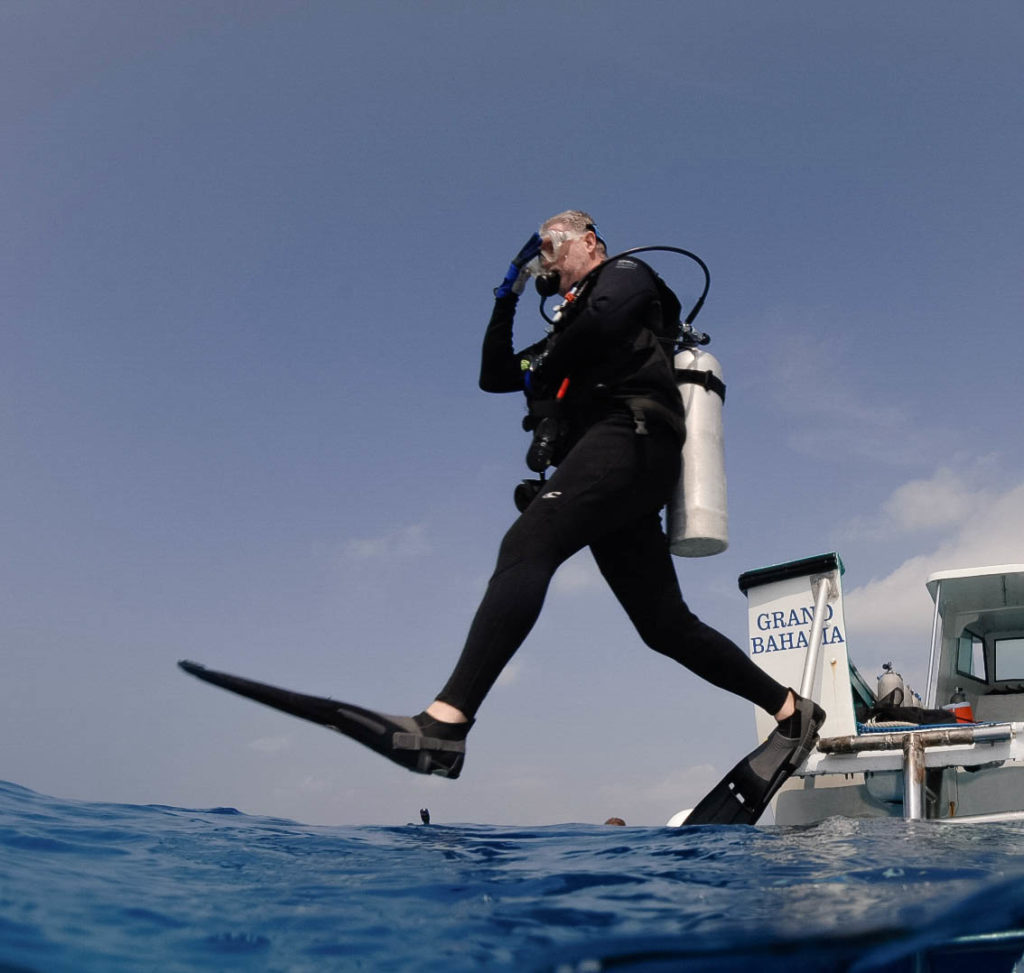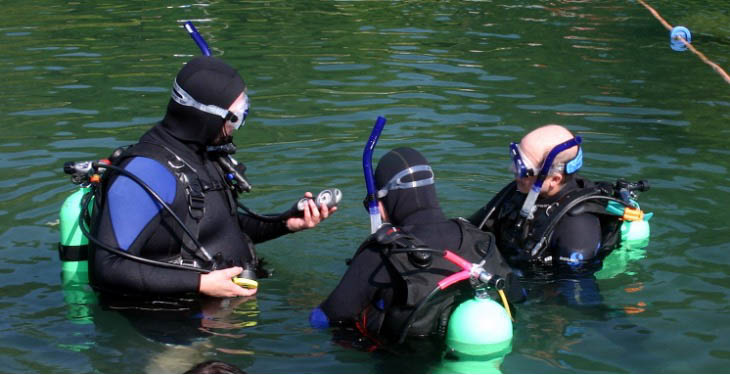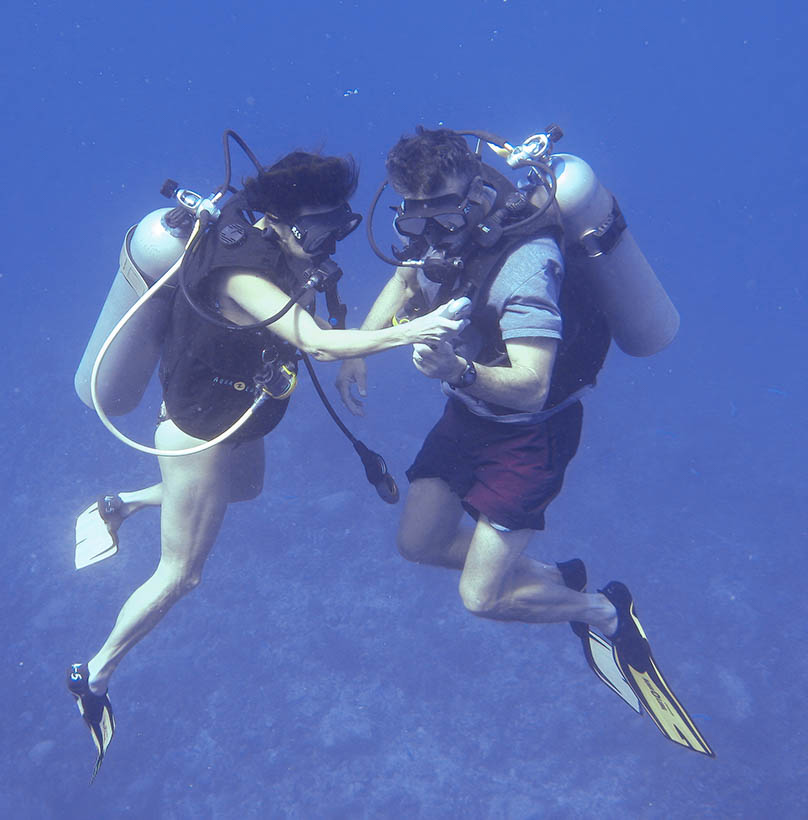As we know all too well, the pandemic has had a devastating effect on the global diving industry and on our sport. Many of us have been out of the water for more than a year and we are itching, and for many of us, desperate to get back underwater. As more and more of our diving compatriots are getting vaccinated and popular dive locations around the world slowly and cautiously begin to open, we must be careful that our enthusiasm to return to the water doesn’t overtake our ability to use all the skills necessary to safely and enjoyably return to diving. Scuba diving is not, as the old saying goes, “like riding a bicycle.” We, therefore, must understand that a prolonged period with no diving means that our skills, especially the critical emergency skills, may have degraded over time.
Skill degradation refers to the loss, decay or deterioration of trained or acquired skills and knowledge after a period of non-use, in our case, non-diving. Skill degradation is a potentially serious issue and certainly problematic in situations where we may not use or practice our skills for extended periods of time. The old adage of “use it or lose it” certainly applies to diving skill degradation.
We know that many emergency situations are the result of a diver, even experienced divers, trying to manage too many things at one time. This condition, known as “task loading,” can occur to divers who have not been in the water in a prolonged period of time and can include, simply trying to get used to equipment you haven’t used in a long time, problems with getting properly weighted or neutrally buoyant, difficulty clearing your ears or the emotional stress of just being underwater again. The result is a condition called “perceptual narrowing” and it limits what we are able to perceive in times of stress and, in my mind, an even more critical condition known as “response narrowing.” Response narrowing is a condition that, when under stress, divers can only effectively use skills that have been recently practiced and reinforced.
Before making any recommendations on how we may safely return to the water after a long absence, we should address the concept of skill degradation or, sometimes referred to as “skill decay or deterioration,” as a function of time. Many of our most critical diving skills, especially those necessary to manage a diving emergency, are complex psychomotor skills that, without frequent practice and reinforcement, certainly do degrade over time. While there is no published research or studies specifically addressing the degrading of critical skills in scuba diving, there are studies done on the loss of proficiency in complex psychomotor skills necessary to adequately perform emergency first aid, surgical and piloting skills as a function of time without practice.
There has been considerable research published on the evaluation and optimization of methods for maintaining or retraining skilled performance by the medical community, private and commercial pilots and the U.S. military. In research involving deterioration of skill performance in Paramedics, it was shown that Advanced Life Support (ALS) skills deteriorate significantly within six months following the paramedic’s completion of their training class. With third-year medical students, there was a significant decline in emergency skill performance after six weeks of nonuse and nonpractice. When nurses were evaluated for the retention of Advanced Cardiac Life Support (ACLS) skills only 30% passed the skills test at three months and only 14% passed the skills test at twelve months. There is also a significant amount of research on skill degradation in pilots both civilian and military. Elements of pilot skill degradation, as a function of time without practice has been extensively evaluated. These studies involved both emergency procedures (combination of cognitive and psychomotor tasks) and flight control (primarily continuous psychomotor tasks). The results showed that both procedural and control skills deteriorated significantly after one to four months of inactivity. In studies involving U.S. Military Reservists, the correlation between skill retention and the length of non-practice or nonuse interval was distinctly negative. That is, after more than 365 days of nonuse or nonpractice, the average reservist was performing essential military skills at a significantly lower level than before the nonpractice interval.
Knowing that skill degradation is a function of time associated with nonuse, think back to the scuba course you took where you learned the complex skills involved in diving or the last time you practiced critical diving skills necessary to successfully manage situations underwater. From the moment you finished the course or last practiced your skills, your knowledge and skills began to degrade. This phenomenon is, unfortunately, a fact of life. But what can we do about it? Safety conscious divers understand that, once our formal training is over, we have the responsibility to maintain our skills at a level where we can act and react with the speed and proficiency necessary to safely manage any situation.
Since it has been clearly demonstrated in numerous research studies that there is a direct correlation between the time away from using or practicing a skill and the amount of skill degradation, we must take steps to make sure that our ability to perform essential skills is at an optimal level before we return to the water. The amount of skill degradation will depend on a variety of factors that are almost impossible to measure and quantify. As I have said in the past, “Scuba diving is inherently safe, but it is very unforgiving of mistakes!” This saying is actually a modification of the motto of the famed Lafayette Escadrille in World War I. They had a sign over their Quonset hut in France that read, “Flying is inherently safe, but it is mercilessly unforgiving of mistakes!” As discussed previously, there are many parallels between flying and diving. Each require meticulous preparation and a thorough understanding of how to successfully manage situations in an environment that can be very unforgiving. And, in both flying and diving, it is certainly very bad to run out of air! International diver training organizations, dive centers and instructors understand the concept of skill degradation and introduce the concept to divers as part of their initial training. These groups also understand that sometimes divers need a formalized method of practicing diving skills in a safe and secure way under the supervision of training and qualified instructors. This is done through refresher training programs. The value of refresher training programs is that they provide a structured way for divers to refamiliarize themselves with diving equipment (including new innovations and equipment designs) and skill practice under the direct supervision of an experienced instructor. There are also other ways to refresh skills and knowledge if refresher programs are not available. Dive clubs may provide opportunities for organized pool practice sessions and even openwater dives structured to allow divers to re-familiarize themselves with their equipment and skills in a shallow, benign dive site. If these situations are not available, divers are encouraged to seek out dive locations that are shallow with plenty of bottom reference to practice their skills. In situations like this, divers are encouraged to have a surface float for additional safety and as a surface station to rest, if necessary. Divers are also encouraged to dive in a slow and deliberate manner and not venture deeper until they are completely comfortable with their equipment and are confident in their skills before moving beyond shallow water. This, as you can imagine, will require a very capable and understanding diving companion.
Another thing to consider when preparing for diving, whether returning to the sport from a prolonged absence or simply wanting to make sure that you are prepared for each and every dive, is the concept of “dynamic rehearsal practice.” A fundamental difference in skill degradation has been demonstrated by the findings that “static rehearsal” (review of training manuals, checklists, photographs only) had value in terms of delaying knowledge degradation while dynamic rehearsal practice (practice on actual equipment) appeared necessary for the retention of manual or mechanical skills. Static practice can be reinforced through the use of a checklist. I have lectured and written frequently about the value of checklists in pre-dive preparation. This has been emphasized in recommendations from the Rebreather Forum 3.0 Proceedings (http://media.dan.org/RF3_web.pdf). But the use of even the most comprehensive checklist alone cannot completely prepare a diver for the possibility that they may be called upon to use a critical emergency skill in a diving emergency.
It has been clearly demonstrated that the time period when skills begin to degrade could be as short as a one month for critical complex psychomotor skills. Therefore, it could be in the best interest of diving safety to adopt a “dynamic rehearsal practice” regimen. This pre-dive practice regimen may include reviewing the mechanics of critical skills such as providing breathing gas to a companion in an out-of-breathing gas emergency, the jettison of weights and even a review of hand signals prior initiating each dive. When I was teaching recreational and scientific diving at Wright State and Florida State Universities, we would have student divers perform a form of dynamic rehearsal practice that we referred to as, “proper pre-dive procedures.” The effective and consistent use of “dynamic rehearsal practice” is, therefore, an important and critical safety consideration. Dynamic rehearsal practice or proper pre-dive procedures can’t and shouldn’t replace actual practice.
Without the right circumstances, it’s difficult to practice the mechanics of an out-of-breathing gas emergency and very difficult to practice the jettison of weights. If you decide to use a “static rehearsal” by simply verbally reviewing the “what ifs” or what you would do in an emergency, that may provide some benefit, but it is not as beneficial as “dynamic rehearsal practice” where you are actually using the mechanics of the skills you may need to use. Some divers, under ideal conditions, practice the mechanics of an out-of-breathing gas emergency at the end of their safety stop as they return to the surface from a dive. Other divers who, when shore diving, practice the mechanics of an out-of-breathing gas emergency when the conditions are right in shallow water just prior to their return to the shore. Also, some divers who, once back on shore, rather than casually removing their BCD with integrated weights, actually practice the jettison of BCD weight pockets or pouches making sure they don’t accidently fall onto someone’s feet or any equipment. Better yet, you could practice removal of the weight pockets or pouches from a weight-integrated BCD with no weights in the pockets or pouches. I have done this numerous times when renting a BCD design that I have not used before. On one of my last trips where I rented a BCD, my diving partner and I spent time on the dive deck practicing the removal of the weight pockets or pouches from our BCDs and then practicing the removal of the empty weight pockets or pouches from each other’s BCD.
As we have discussed, it is a fact of life that skills, especially complex psychomotor skills degrade over time. How quickly and to what extent is unknown or, at least, poorly understood. With that in mind, when the time comes to make that long awaited migration back to the water, it is always better to take a thoughtful and cautious approach. Whether that migration involves a refresher course, a dive with a local dive club under the most benign conditions or doing a “warm up” dive under the most benign conditions, it is good to have good bottom reference and/or use a descent or anchor line where you can choose to stop when, and if, necessary. Under any condition, it is always good to dive with a well-trained diving companion who has compatible skills and an understanding attitude. When choosing a good companion, I believe it is important to consider how that person would and could act and react if you were the one who needed help in the unlikely event of an underwater emergency. Both diving companions should have that level of confidence in each other, and it is incumbent upon each diver to make sure that they and their skills are up to the task. Before you make that migration back to the water, remember the four “Ps” of diving safety: Plan you dive and dive your plan, Prepare by thinking of all possible contingencies, Practice your diving and critical emergency skills often and Perform the skills like your life depended upon it.
Scuba diving is like no other sport on earth so ensure that when you return to the water, you do so safely and responsibly.
Article kindly submitted by Dan Orr of Dan Orr Consulting
References
Degradation of Learned Skills. Sitterley, Thomas. NASA. 1974
Measuring Skills Degradation Over Time. Corry, Megan. EMS World. March 2018.
Evaluation of Staff’s Retention of ACLS and BLS Skills. Smith, K. et al. Resuscitation. Vol. 78. Issue 1. 2008. Pgs. 39-45.
Factors That Influence Skill Decay and Retention: A Quantitative Review and Analysis. Arthur, Winfred. Et al. Human Performance, 1998.
Advanced Life Support Skill Deterioration Among Paramedics in Low Call Volume Emergency Medical Service Systems. Williams, Gregory. October 2009.
Scuba Diving Safety. Orr, D. and Douglas, E. Best Publishing Company. 2007
Normalization of Deviance aka Shortcut Mentality. Orr, Dan. DeeperBlue.com. 2021.
Rebreather Forum 3.0 Proceedings. Vann, D, Lang, M. Pollack, N, editors. Divers Alert Network, 2012.
Diving after COVID-19 – Update from Coronavirus Survivor. Ebersole, Douglas MD. DiveNewsWire May 11, 2020. (https://www.divenewswire.com/diving-after-covid-19-update-from-coronavirus-survivor-douglas-ebersole-md/).
Return To Diving Safely. Divers Alert Network https://dan.org/safety-prevention/return-to-diving-safely/
Pre-performance routines in sport: Theoretical support and practical applications. Cohn PG, The Sport Psychologist 4: 312-381 1990.









